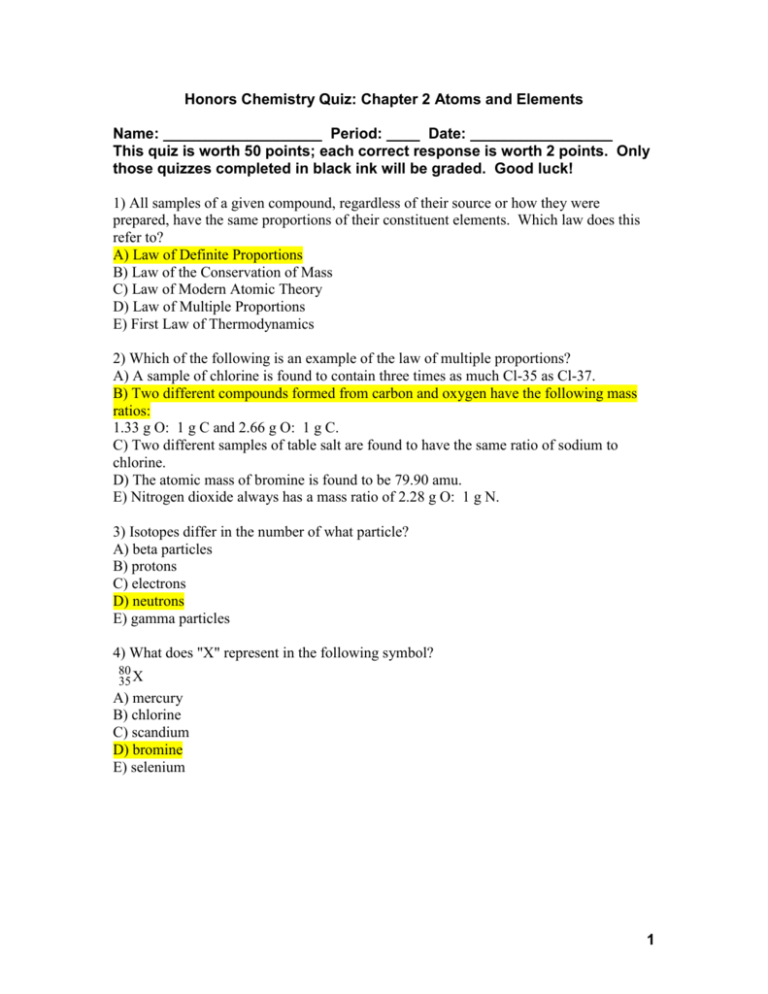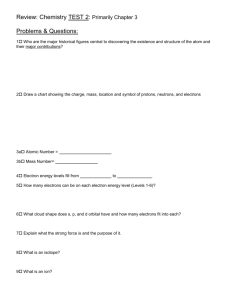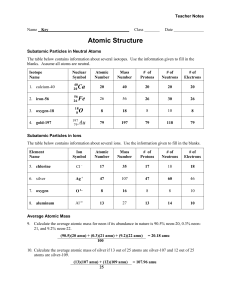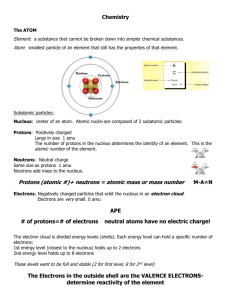Honors Chemistry Quiz: Chapter 2 Atoms and Elements - Doc-U-Ment
advertisement

Honors Chemistry Quiz: Chapter 2 Atoms and Elements Name: ___________________ Period: ____ Date: _________________ This quiz is worth 50 points; each correct response is worth 2 points. Only those quizzes completed in black ink will be graded. Good luck! 1) All samples of a given compound, regardless of their source or how they were prepared, have the same proportions of their constituent elements. Which law does this refer to? A) Law of Definite Proportions B) Law of the Conservation of Mass C) Law of Modern Atomic Theory D) Law of Multiple Proportions E) First Law of Thermodynamics 2) Which of the following is an example of the law of multiple proportions? A) A sample of chlorine is found to contain three times as much Cl-35 as Cl-37. B) Two different compounds formed from carbon and oxygen have the following mass ratios: 1.33 g O: 1 g C and 2.66 g O: 1 g C. C) Two different samples of table salt are found to have the same ratio of sodium to chlorine. D) The atomic mass of bromine is found to be 79.90 amu. E) Nitrogen dioxide always has a mass ratio of 2.28 g O: 1 g N. 3) Isotopes differ in the number of what particle? A) beta particles B) protons C) electrons D) neutrons E) gamma particles 4) What does "X" represent in the following symbol? 80 35 X A) mercury B) chlorine C) scandium D) bromine E) selenium 1 5) Determine the number of protons, neutrons and electrons in the following: 40 18 X A) p+ = 18 n° = 18 B) p+ = 18 n° = 22 C) p+ = 22 n° = 18 D) p+ = 18 n° = 22 E) p+ = 40 n° = 22 e- = 22 e- = 18 e- = 18 e- = 40 e- = 18 6) What element is defined by the following information? p+ = 11 n° = 12 e- = 11 A) sodium B) vanadium C) magnesium D) titanium E) none of the above 7) Which of the following statements about subatomic particles is TRUE? A) A neutral atom contains the same number of protons and electrons. B) Protons have about the same mass as electrons. C) Electrons make up most of the mass of an atom. D) Protons and neutrons have opposite, but equal in magnitude, charges. E) Neutrons and electrons are found in the nucleus of an atom. 8) Give the symbol for Zinc. A) S B) Si C) Ar D) Ag E) none of the above 9) What species is represented by the following information? p+ = 12 n° = 14 e- = 10 A) Si4+ B) Mg C) Ne D) Si E) Mg2+ 2 10) Predict the charge that a calcium ion would have. A) 6B) 2C) 3+ D) 2+ E) 1+ 11) Give the number of electrons in P-3. A) 18 B) 12 C) 19 D) 15 E) 16 12) Which of the following elements is NOT a metal? A) Ba B) Mg C) Xe D) Pb E) Ga 13) Which of the following elements is a halogen? A) Ne B) I C) O D) Mg E) K 14) Which of the following elements is a metalloid? A) Al B) Ge C) C D) Sn E) Pb 15) Which of the following statements is FALSE? A) Halogens are very reactive elements. B) The alkali metals are fairly unreactive. C) Sulfur is a main group element. D) Noble gases do not usually form ions. E) Zn is a transition metal. 3 16) Which of the following does NOT describe a nonmetal? A) tend to gain electrons B) found in the upper right hand corner of the periodic table C) poor conductor of electricity D) nonmetals are generally unreactive E) poor conductor of heat 17) The atomic mass for cadmium (Cd) is A) 48 B) 112.41 C) 40.08 D) 20 E) 30 18) Calculate the atomic mass of silver if silver has 2 naturally occurring isotopes with the following masses and natural abundances: Ag-107 Ag-109 106.90509 amu 108.90476 amu 51.84% 48.46% A) 107.90 amu B) 108.00 amu C) 107.79 amu D) 108.32 amu E) 108.19 amu 19) Gallium has an atomic mass of 69.723 amu. The Ga-69 (68.926 amu) is 60.11%. What is the amu of the other isotope? A) 70.924 amu B) 70.928 amu C) 70.932 amu D) 70.920 amu E) 69.723 amu 20) How many silver atoms are contained in 3.75 moles of silver? A) 6.23 × 1024 silver atoms B) 2.26 × 1024 silver atoms C) 1.61 × 1023 silver atoms D) 2.44 × 1026 silver atoms E) 6.50 × 1025 silver atoms 4 21) What mass (in g) does 3.99 moles of Kr have? A) 334 g B) 476 g C) 211 g D) 240 g E) 144 g 22) How many moles are in 2.16 x 1024 atoms of lead? A) 35.9 moles B) 3.59 moles C) 0.359 moles D) 6.08 moles E) 1.79 moles 23) How many iron atoms are contained in 354 g of iron? A) 2.62 × 1025 Fe atoms B) 2.13 × 1026 Fe atoms C) 4.69 × 1024 Fe atoms D) 3.82 × 1024 Fe atoms E) 9.50 × 1022 Fe atoms 24) Who determined the charge of an electron? A) Millikan B) Thomson C) Chadwick D) Rutherford E) Einstein 25) To determine the relative abundance of the individual isotopes of an element, chemists will often use A) Radioactive decay B) Mass spectrometer C) Number of protons D) Cathode-ray tube E) Bombarding the nucleus with alpha particles 5






